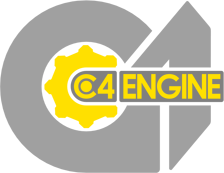The architecture of the C4 Engine is that of a layered collection of software components, [4] in which the lowest layers interact with the computer hardware and operating system, and the higher layers provide platform-independent services to the game code. While a considerable portion of the engine is dedicated to 3D graphics, there are also large components dedicated to functionality pertaining to audio, networking, physics, input devices, and scripting. Documentation for the engine is available online through a set of API web pages and a wiki. [5]
Graphics
The C4 Engine is based on the OpenGL library [6] on Windows, Mac, Linux, and iOS platforms, and it uses a one-pass-per-light forward rendering model. The engine is capable of rendering with several different types of light sources and shadowing methods. [7] The primary method for rendering dynamic shadows is shadow mapping, and a variant of cascaded shadow mapping is used for very large outdoor scenes.
Shaders are created in C4 using one of two available methods, both of which isolate the user from the shader code required by the underlying graphics library. Simple shaders can be created by specifying a set of material attributes such as a diffuse reflection color, a specular reflection color, and a group of texture maps. The engine internally generates the necessary shader code for each combination of material and light type that it encounters when rendering a scene. Material attributes can be used to produce effects such as normal mapping, parallax mapping, horizon mapping, and bumpy reflections or refractions. [8]
C4 also includes a graphical Shader Editor that allows complex custom materials to be created using a large set of predefined operations. [9] This method of designing materials enables greater creative freedom and functionality for expert users, but requires somewhat more work by the user. Materials created using the standard material attributes can be converted to custom shaders to serve as a starting point in the Shader Editor.
The terrain capabilities of the C4 Engine are based on a voxel technology, [10] allowing full 3D sculpting to produce features such as overhangs, arches, and truly vertical cliffs that would not be possible under a conventional height-based terrain system. Triangle meshes are generated from voxel data using the Marching cubes algorithm, and seamless multiresolution level of detail is made possible by using the Transvoxel algorithm to stitch together regions of differing resolutions.
The engine is capable of rendering a large variety of special effects, including particle systems, procedural fire, electrical effects, volumetric fog, and weather phenomena. [11] During a post-processing stage, the engine can also apply full-scene cinematic motion blur to the final image using a technique based on a velocity buffer, [12] as well as glow and distortion effects. The engine does not provide the capability to design custom post-processing effects.
